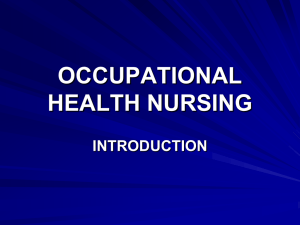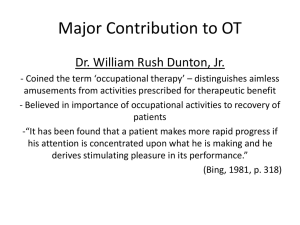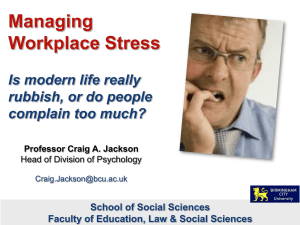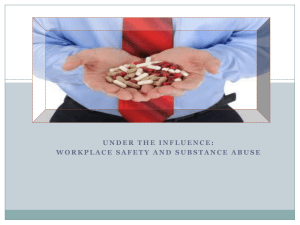Occupational Health in Agriculture
advertisement
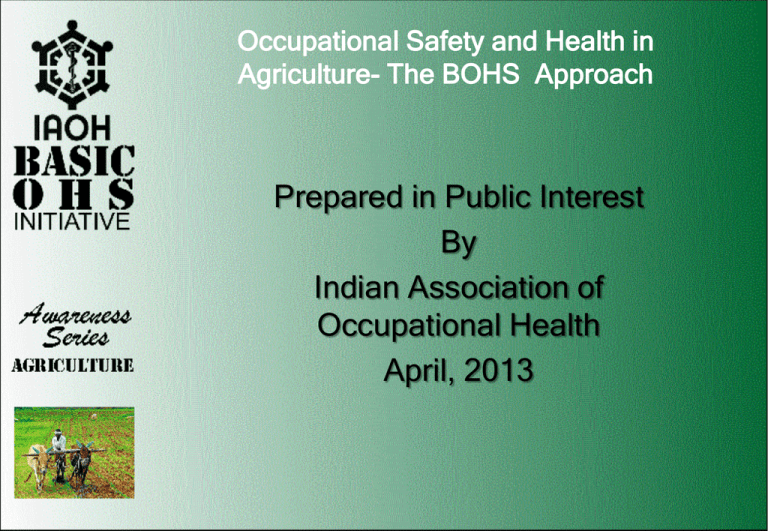
Occupational Safety and Health in Agriculture- The BOHS Approach Prepared in Public Interest By Indian Association of Occupational Health April, 2013 2 IAOH - 2013 DEFINATION OF AGRICULTURE Agricultural and forestry activities carried out in agricultural undertakings including Crop production, forestry activities, animal husbandry and insect raising, the primary processing of agricultural and animal products by or on behalf of the operator of the undertaking. As well as the use and maintenance of machinery, equipment, appliances, tools, and agricultural installations, including any process, storage, operation or transportation in an agricultural undertaking, which are directly related to agricultural production. REF: ILO convention no. 184 3 IAOH - 2013 INTRODUCTION An estimated 1.3 billion workers are engaged in agricultural production worldwide. This represents half of the total world labour force. Almost 60% of them are in developing countries. A great majority of agricultural workers are found in Asia, which is the most densely populated region of the world, with more than 40% of the world's agricultural population concentrated in China and more than 20% in India. 4 IAOH - 2013 SPECIFIC FEATURES OF AGRICULTURE most tasks are carried out in the open air, exposing workers to climatic conditions; the seasonal nature of the work and the urgency of certain tasks in specific periods; a wide variety of tasks are performed by the same person; the type of working postures and the length of the tasks performed; 5 IAOH - 2013 SPECIFIC FEATURES OF AGRICULTURAL WORK contact with animals and plants exposing workers to bites, poisoning, infections, parasitic diseases, allergies, toxicity and other health problems; the use of chemicals and biological products ; the considerable distances between living quarters and workplaces. 6 IAOH - 2013 LABOUR FORCE IN AGRICULTURE Lack of clear-cut distinctions between different categories of workers. Numerous types of labour relations and different forms of labour force participation. 7 IAOH - 2013 PRINCIPLES OF BOHS The following principles will be applied in the organization of Basic Occupational Health Services: Available to all working people Addressing to local needs Adapted to local conditions Affordable to providers and clients Organized by the employer for employees Provided by the public sector for the self-employed and the informal sector Supported by intermediate level services 8 IAOH - 2013 BOHS MODEL 9 IAOH - 2013 ORIENTATION AND PLANNING 1. Analysis of the type of production indicating the risks and problems typical of the branch or occupation in concern. Agriculture involves a wide range of different types of machinery, animals, plants and products, working in both indoor and outdoor environments In India labour-intensive farming is much more common. 2. Review of problems that have been identified previously in the company 3. Review of the characteristics of the workforce of the company child labour , migrant workers , seasonal, migratory and casual labour. 10 IAOH - 2013 ORIENTATION AND PLANNING 4. Available data on occupational diseases and accidents 5. Data on working methods, chemical substances, etc. 6. The knowledge by employers and employees of occupational health problems 7. Plans for changes in production systems, e.g. installation of new facilities, machinery and equipment 11 IAOH - 2013 SURVEILLANCE OF THE WORK ENVIRONMENT 1. Identification and evaluation of ergonomic factors which may affect the workers' health Ergonomic factors affecting the health outcomes of agricultural workers include: the nature of the physical work environment (noise, heat, lighting, thermal comfort), the agricultural tasks to be performed; the technology applied to the prescribed tasks (including workplace design, facility design, and agricultural material handling); the manner in which tasks are organized (including use of shift work); and Worker characteristics (including demographics, physiology, human error, and identification and treatment of injured workers). 12 IAOH - 2013 SURVEILLANCE OF THE WORK ENVIRONMENT 2. Assessment of conditions of occupational hygiene and factors, such as physical, chemical, and biological exposures which may generate risks to the health of workers 2. Assessment, where appropriate, of exposure of workers to adverse psychological factors and aspects of work organization 3. Assessment of risk of occupational accidents and major hazards 4. Assessment of collective and personal protective equipment 5. Assessment of control systems designed to eliminate, prevent or reduce exposure 6. Assessment of general hygiene and sanitary facilities 13 IAOH - 2013 Occupational Health Problems in Agriculture Risk of traumatism Seasons, Unstable loading Physical work stress, Accumulation of fatigue The overtension diseases Over heating, Over cooling Open Air work Weather Conditions, Dust Dust diseases Noise, Vibration Use of new technology and machinery Hearing loss, Vibration diseases Chemical pollution of environment Pesticides, fertilisers etc. Sensitization, Allergic diseases Contact with animals and biopreparations Biological hazards Zoo-Anthroponoses 14 IAOH - 2013 Occupational Health Problems in Agriculture Seasons, Unstable loading Physical work stress, Accumulation of fatigue Risk of traumatism The overtension diseases Weather Conditions, Dust Over heating, Over cooling Dust diseases Contact with animals and biopreparations Use of new technology and machinery Open Air work Noise, Vibration Hearing loss, Vibration diseases Pesticides, fertilisers etc. Chemical pollution of environment Sensitization, Allergic diseases Biological hazards ZooAnthroponoses 16 IAOH - 2013 SURVEILLANCE OF WORKERS' HEALTH The following types of health examinations are carried out either on the basis of regulations or as a part of good occupational health practice: 1. Pre-assignment (pre-employment) health examinations 2. Periodic health examinations 3. Return to work health examinations 4. General health examinations 5. Health examinations at termination or after ending of service A new type of health examination has recently been introduced for assessment of work ability of ageing workers. 17 IAOH - 2013 SURVEILLANCE OF WORKERS' HEALTH In the case of exposure of workers to specific hazards, medical and health surveillance should include, where appropriate, any examination and investigations which may be necessary to detect exposure levels and early effects and responses which also bear in mind the biological difference between women and men. Example, in pesticide handlers. Pre-employment screening should ensure that those with inherently low-level cholinesterase do not undertake work with organophosphate or carbamate pesticides baseline samples, periodic samples, 18 IAOH - 2013 ASSESSMENT OF HEALTH AND SAFETY RISKS A “hazard” is anything with the potential to do harm, whereas a “risk” is the likelihood of potential harm from that hazard being realised. The identification of hazards in the workplace should take into account: (a) the situation or events or combination of circumstances that have the potential to give rise to injury or illness; (b) the nature of potential injury or illness relevant to the activity, product or service; (c) those likely to be harmed (e.g. young workers, older workers, temporary workers, pregnant workers); and (d) past injuries, incidents and illness. 19 IAOH - 2013 ASSESSMENT OF HEALTH AND SAFETY RISKS The steps in an occupational health risk assessment include: 1. Identification of occupational health hazards (as a result of surveillances) Hazards Mechanical hazard Psycho social hazards Work organisation hazards Ergonomic hazards Description Poorly designed and/or guarded agricultural machinery is a major cause of fatalities and accidents. Injuries from cutting tools are another major risk. low pay, sexual and other harassment, job insecurity, poor promotion mechanisms, delay in payment of salaries. badly organised shift work and working hours, excessive overtime, lone working, lack of control over work. These hazards can cause permanent injuries and disablement. For example: badly designed machinery, prolonged static working positions, repetitive work, unsuitable tools used by workers, poor seating Others - Physical hazards , Biological hazards, chemical hazards, environmental 20 IAOH - 2013 ASSESSMENT OF HEALTH AND SAFETY RISKS 2. Identification of workers or groups of workers exposed to specific hazards for e.g. in tea plantation workers the hazards are different for pruners, pluckers, sprayers 3. Analysis of how the hazard may affect the worker (ways of entry and type of exposure, threshold limit values, dosage/ response relationships, adverse health effects it may cause, etc.in case of sprayers who are in constant contact with the pesticides) 4. Determination of intensity (level) and magnitude (volume) of risk 21 IAOH - 2013 ASSESSMENT OF HEALTH AND SAFETY RISKS 5. Identification of individuals and groups with special vulnerabilities, e.g. young workers, old workers, pregnant workers, temporary workers 6. Evaluation of available hazard prevention and control measures 7. Making conclusions and recommendations for the management and control of risks 22 IAOH - 2013 ASSESSMENT OF HEALTH AND SAFETY RISKS Hierarchy of control measures for reducing risks in the work place. A. Elimination B. Substitution C. Others technical and engineering control- enclosure, isolation, ventilation Safe systems of work- changing work schedules, extending rest periods, training and information Issuing Personal Protective Equipment (PPE) 8. Documenting the findings of the assessment 9. Periodic review and, if necessary, reassessment of risks 23 IAOH - 2013 INFORMATION AND EDUCATION ON RISKS AND ADVICE ON THE NEED FOR PREVENTIVE AND CONTROL ACTIONS The information and education include the following aspects: 1. Workers in agriculture should have the right to be informed and consulted on OSH matters including risks from new technologies; and 2. The workers have a right to know and get continuously information on hazards related to their own work and the workplace. 3. The employer is responsible for training the workers on safe and healthy work practices. 24 IAOH - 2013 INFORMATION AND EDUCATION ON RISKS AND ADVICE ON THE NEED FOR PREVENTIVE AND CONTROL ACTIONS 4. The workers have a duty to follow the safety instructions and safe and healthy work practices. 5. Confidential health information of an individual worker is subject to special legislation and practices and to informed consent. 6. The advice provided by OHS personnel must be given in a form which is easily understood by employers and workers. 7. Information given to various partners should be documented. 25 IAOH - 2013 PREVENTIVE ACTIONS FOR THE MANAGEMENT AND CONTROL OF HEALTH AND SAFETY HAZARDS AND RISKS Control measures should be monitored and reviewed at regular intervals and if necessary revised, especially when circumstances change or if new information becomes available about the risks posed or the suitability of existing control measures. Control measures should also be reviewed and if necessary revised following an accident. 26 IAOH - 2013 PREVENTIVE ACTIONS FOR THE MANAGEMENT AND CONTROL OF HEALTH AND SAFETY HAZARDS AND RISKS The risk management actions may comprise: • Control of hazards at the source • Ventilation or control technology • Dust control • Ergonomic measures • Use of personal protective equipment • Regulation of thermal conditions, etc. 27 IAOH - 2013 PREVENTION OF ACCIDENTS 1. Safe planning of facilities, machinery, etc. The employer should not permit the use of any unsafe or faulty equipment. The employer should ensure the provision of adequate information, instruction and training for those using equipment, and that their skill levels are periodically evaluated. 2. Good housekeeping, order and cleanliness The employer should ensure that workers are clearly instructed and supervised in good housekeeping measures that can prevent slips, trips and falls. 28 IAOH - 2013 PREVENTION OF ACCIDENTS 3. Making walkways and other structures safe (e.g. scaffolds, fences) The employer shall ensure that: walking surfaces and stairs inside facilities are equipped with adequate lighting; stairs and ladders are maintained in good condition with handrails in place; . 4. Guarding dangerous machines- by providing enclosures, safety symbols surrounding such places. Unauthorized persons should not be allowed to operate machinery. In particular, children should be kept away from all agricultural equipment. 29 IAOH - 2013 PREVENTION OF ACCIDENTS 5. Technical aids for moving and lifting heavy loads With regard to the use and maintenance of ladders, the employer should ensure that appropriate, well-maintained equipment is available and is appropriate to the task at hand. the use of mechanical means to lift or lower heavy objects; and other practices appropriate to the task at hand. 6. Safe tools and safety equipment for workers Workers should use handholds when mounting and dismounting equipment. 7. Analysis of major hazard risks and provision of "redundant safety" 30 IAOH - 2013 MAINTAINING PREPAREDNESS TO FIRST AID AND PARTICIPATION IN EMERGENCY PREPAREDNESS 1. Providing first aid services at the workplace when appropriate 2. Introducing and training first aid practices to workers and supervisors 3. Maintaining and periodically inspecting the first aid readiness and facilities 4. Participating from the health point of view in emergency planning and organizing the health elements in emergency response 31 IAOH - 2013 MAINTAINING PREPAREDNESS TO FIRST AID AND PARTICIPATION IN EMERGENCY PREPAREDNESS Emergency preparedness Date______________ Checklist Self-audit Step Step2 Step 3 1 Planning N/A Yes No Priority for action What action is required 1. Does the workplace have an emergency response plan? 2. Does the workplace have established emergency escape routes and procedures? 3. Does the workplace have a trained first-aider(s)? 4. Does the workplace have basic rescue equipment and are workers trained to use it? 32 IAOH - 2013 DIAGNOSIS OF OCCUPATIONAL AND WORKRELATED DISEASES 1. Identification of exposure which may cause the disease 2. Examination of clinical findings which are known to be associated with the specific exposure (lists of occupational diseases) 3. Exclusion of non-occupational factors as a possible cause of disease 4. Conclusion on existence or non-existence of occupational disease (diagnosis) 5. Statement on occupational disease for workmen's compensation 6. Proposals for preventive actions to the workplace of the worker in concern 7. Notification of occupational diseases to authorities 33 IAOH - 2013 GENERAL HEALTH CARE, CURATIVE AND REHABILITATION SERVICES 1. Immunizations and other preventive measures 2. Participation in public health actions and programmes 3. GP-level general health services 4. Inspection and advice on canteens, sanitary facilities 5. Advice and education in general personal and community hygiene 6. Actions for rehabilitation and adjustment of work for workers after injuries, diseases, reduced work ability and on return to work from long sick leaves 7. General health promotion and introduction of healthy lifestyles 34 IAOH - 2013 RECORD KEEPING 1. General health record, if the workers are treated as patients or health service clients 2. Data on surveyed, detected and measured occupational exposures and risk assessments made 3. Statistics on occupational diseases and injuries 4. Data on health examinations 5. Documents on proposals for preventive and control measures 35 IAOH - 2013 EVALUATION 1. Evaluation is carried out as an inbuilt part of BOHS activity, at least annually 2. Evaluation is made when the working methods, production structures or other aspects at work are substantially changed 3. Evaluation is made if the methods or conditions of operation of services are substantially changed 36 IAOH - 2013 EVALUATION 4. The following questions are answered through evaluation: a) Do the services respond to the needs of the workplace? b) Are the activities directed to priority problems? c) Is good occupational health practice followed? d) Are the resources, human and technical, sufficient? e) Are the services effective in elimination of health problems? f) What can be improved? 37 IAOH - 2013 ROVISION OF BOHS Primary health services model Big company model with in-company services Group services organized jointly, e.g. by several SMEs Social security institution as a service provider Private physician who has special competence in occupational health Private health centre either providing occupational health services only or occupational health as a part of its services Local or regional outpatient clinic of hospitals 38 IAOH - 2013 AIMING FOR THIS CHANGE IAOH - 2013 39 40 IAOH - 2013 REFERENCES BOHS. a response to the Joint ILO/WHO Committee on Occupational Health priority area for ILO/WHO/ICOH collaboration, with support of the Finnish Institute of Occupational Health (FIOH). Author: Professor Jorma Rantanen. 3rd, revised edition, Helsinki 28 September 2007 Safety and health in agriculture. Programme on safety, health and the environment. Labour Protection Department. ILO. Code of practice on safety and health in agriculture .2010. INTERNATIONAL LABOUR OFFICE GENEVA. Top on the agenda: Health and safety in agriculture. Labour Education 2000/ 1-2 Nos. 118/119. ILO Health, Safety and Environment: A Series of Trade Union Education Manuals for Agricultural Workers Written by: Peter Hurst & Peter Kirby. ILO. 41 IAOH - 2013 CONTRIBUTORS Dr. Shwetha Marali, Senior Resident, Department of Community Health, St. John’s Medical College Dr. Bobby Joseph, Professor and Head, Division of Occupational Health Services of the same Department..


